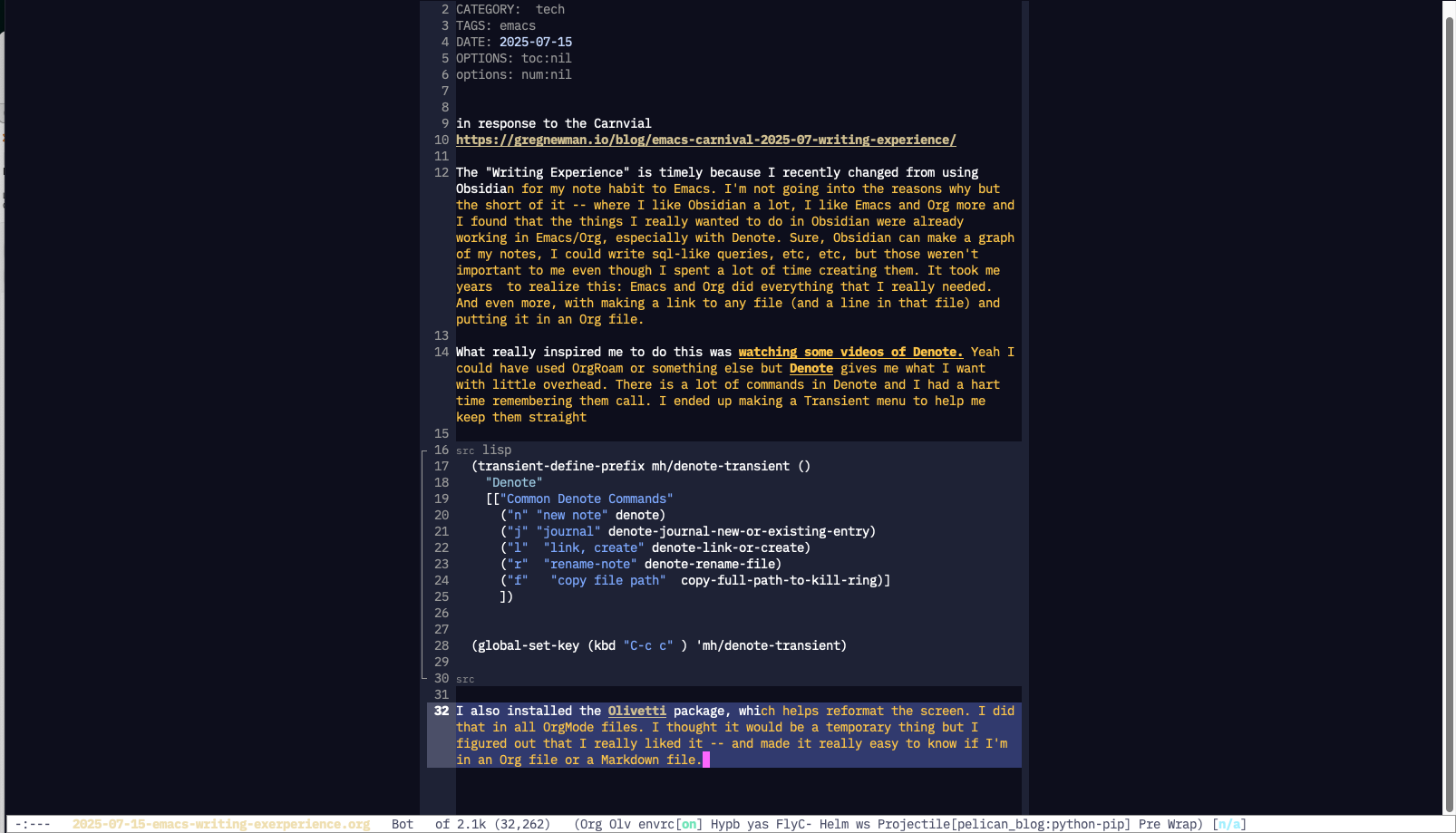
This is to join in on this month's Emacs Blog Carnival: The Writing Experience.
The "Writing Experience" is a timely theme because I recently changed from using Obsidian for my note habit to Emacs. I'm not going into a long list of reasons why but it all comes down to: I like Obsidian a lot, but I like Emacs and Org more. I found that the things I really wanted to do in Obsidian were already working in Emacs/Org, especially with after some config work (more on that below). Sure, Obsidian can make a graph of my notes, I could write sql-like queries to display my notes, etc, etc. I spent a lot of time working on those things instead actually making notes. It took me years to realize this simple fact: Emacs and Org did everything that I really needed. And even more, like making a link to any file (and a line in that file) and putting it in an Org file.
(Ironically, I found Denote Explore while I was writing this post that adds things from Obsidian like graphs, stats, and random walks that could be useful. I haven't played with any of it yet but also proves… Emacs can basically already do what Obsidian is doing.)
What really inspired me to do this was watching some videos of Denote. Yeah I could have used OrgRoam or something else but Denote gives me what I want with little overhead. There is a lot of commands in Denote and I had a hard time remembering them all. I ended up making a Transient menu to help me keep them straight:
(transient-define-prefix mh/denote-transient ()
"Denote"
[["Common Denote Commands"
("n" "new note" denote)
("j" "journal" denote-journal-new-or-existing-entry)
("l" "link, create" denote-link-or-create)
("r" "rename-note" denote-rename-file)
("f" "file path" copy-full-path-to-kill-ring)
("k" "search old vaults" my-xeft-transient)]
])
(global-set-key (kbd "C-c c" ) 'mh/denote-transient)
I also installed the Olivetti package, which helps reformat the screen, which I enabled in all OrgMode files. I thought it would be a temporary thing but I figured out that I really liked it – and made it really easy to know if I'm in an Org file or a Markdown file. The screenshot of this post is exactly how that looks
I'm shockingly very happy with this setup. I realized that I hadn't opened up Obsidian for weeks … accept when I wanted to look something up. Well they are just Markdown files, I should be able to integrate them in to my Denote structure (without converting them all to Denote files). Without having to give every step of the journey, I ended up choosing Xeft, which has a Deft-like interface but doesn't open every file to search. Instead, under the covers, it uses Xapian to index and search the files. The hard part was to get Xeft to switch indexes, depending on which Obsidian vault I wanted to search (yes I had two!). Here is my Xeft setup. It's seemingly simple but it took a while to get to a usable point
The reason I used Obsidian for so many years was mobile. My biggest problem was that I couldn't put my Org notes on my mobile device and have them sync cleanly, nor did I have a way to edit them. Then I realized I had the solution all along – DEVONThink and, more appropriately, DEVONThink To Go. What I did was setup DEVONThink to index my org folder . Then that folder is monitored when I create or edit new Org notes. DEVONThink To Go then gets the files from my Mac running DEVONThink and I can edit them or read them on my phone or iPad. Sure, DEVONThink doesn't understand the Org format like it does Markdown, but it's just text files anyway… I can read and edit the files on my mobile devices… that is the end game for me.
So it seems I'm having my cake and eat it too … I can write my notes in my beloved Emacs and OrgMode and have them on my mobile. And even my "old" Obsidian notes are there. It's a great arrangement.